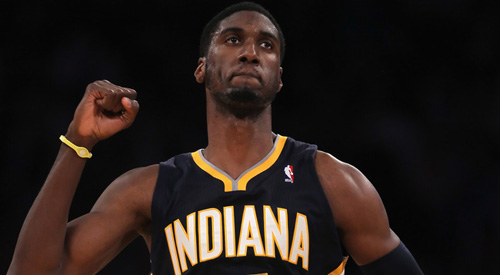
Roy Hibbert: The past, present and future
Entering the 2008 NBA Draft, Roy Hibbert was every general manager’s dream: a defensive-minded big, a hard-nosed rebounder who could score when called upon, a high-character player with good mentality and a Georgetown pedigree to boot. While nobody expected Hibbert to be the next Patrick Ewing or Alonzo Mourning, the comparisons were there.
But for the first time in his life, Roy Hibbert fell short.
In his rookie season, the 7’2″, 280-pound former Hoya put up less-than-stellar numbers: seven points and three rebounds a game in under 15 minutes per. Jim O’Brien’s stale offense, inconsistent rotations and at times inexplicable motivational tactics exposed Hibbert as one whose confidence was easily shaken. His second season saw his stats improve to the naked eye – up to 11.7 and 5.7, respectively, in 25 minutes a game – his efficiency went unchanged.
While an offseason of dedicated effort towards defensive rebounding and defense didn’t go unnoticed, Hibbert’s offensive game was essentially the same as it was when he was drafted; not normally what you want to see in your seven-footer of the future.
By 2010-11, Hibbert and Pacers head coach Jim O’Brien’s relationship had apparently soured so badly that the center would visually give up after minor mistakes. Despite making even greater improvements on the defensive end, his offensive game was still nigh-nonexistent.
Although still only 24 years old, a more disconcerting comparison had started to unfold, one in which Hibbert was no more than a rich man’s Hasheem Thabeet: tall, athletic and defensively gifted, but mentally unreliable and not creative enough on the offensive end.
[php snippet=1]
Part-way through the 2010-11 campaign, however, Hibbert’s third as a pro, Indiana Pacers president of basketball operations Larry Bird shook up the organization and possibly his young center’s career. With the firing of O’Brien and subsequent hiring of Frank Vogel, Bird has injected new life into the franchise. The offense, suddenly, was less Danny Granger-centric than it had been previous, and Roy’s confidence, like that of the rest of his teammates, seemed to swell.
Since the Draft Day trade that sent him to Indiana (from Toronto in the Jermaine O’Neal deal) Pacers fans knew of Hibbert’s potential; he would occasionally piece together 20-10 games and had proven he could shut down the paint with his shot-blocking similar to that of the player he was traded for, but outside of Conseco Fieldhouse, such a reputation waned.
Vogel’s hiring changed that drastically, along with that of the Pacers in general as the club snuck into the Eastern Conference’s No. 8 playoff spot with a 38-44 record.
Though the Pacers were ultimately ousted by the eventual Eastern Conference runner up Chicago Bulls, the increased national exposure gave Hibbert an opportunity to showcase his skills to a wider audience. Along with his usual stellar defense, general NBA fans saw his offensive rebounds, his confident and powerful attacks to the basket, and some slick post moves that finally drew the defense’s attention.
Now, as the young Indiana Pacers head into a critical time in their development, eyes will be on Hibbert to see where exactly he might end up as a player. Vogel will most likely be re-hired, and with a full off-season under their belt, lockout notwithstanding, he and Hibbert can continue to grow as a coach-player-system combination.
He may not cement himself in the upper echelon of classic NBA big men, but all of the pieces seem to be falling together for him to have an outstanding season that could skyrocket a successful career.
[php snippet=1]

